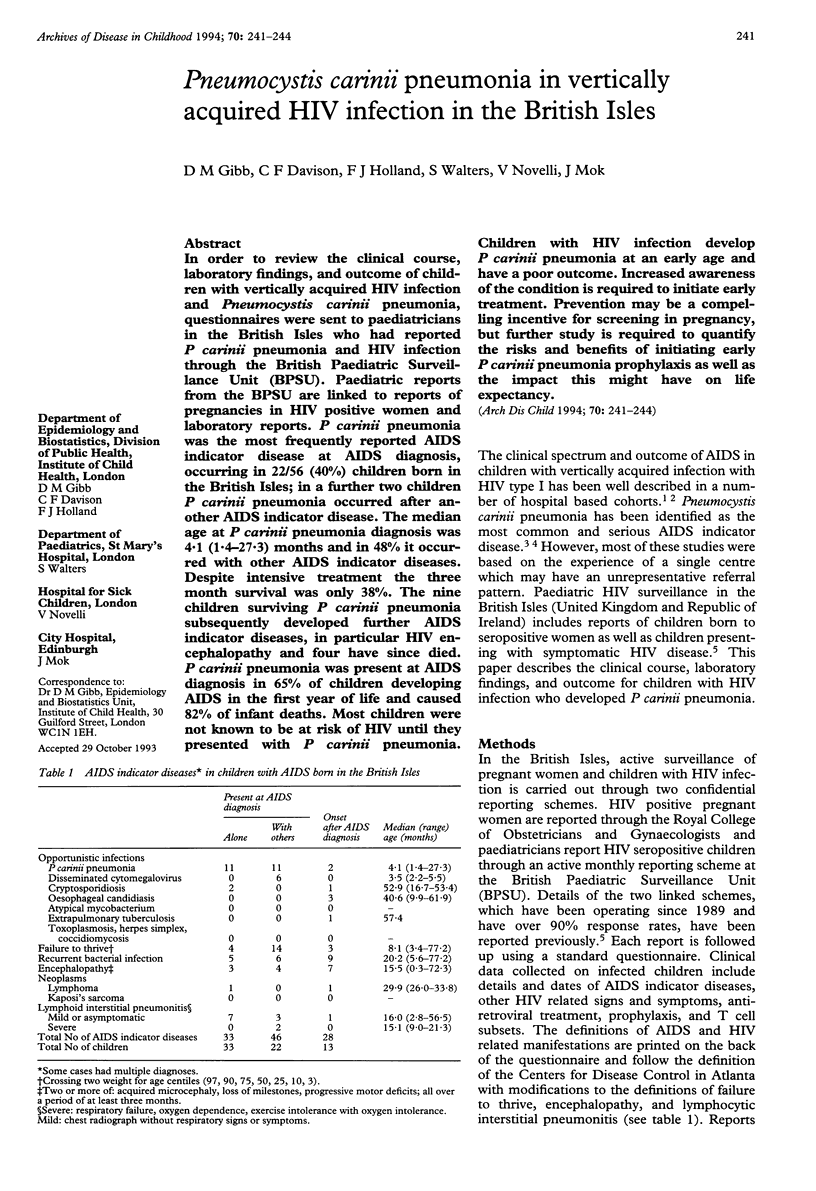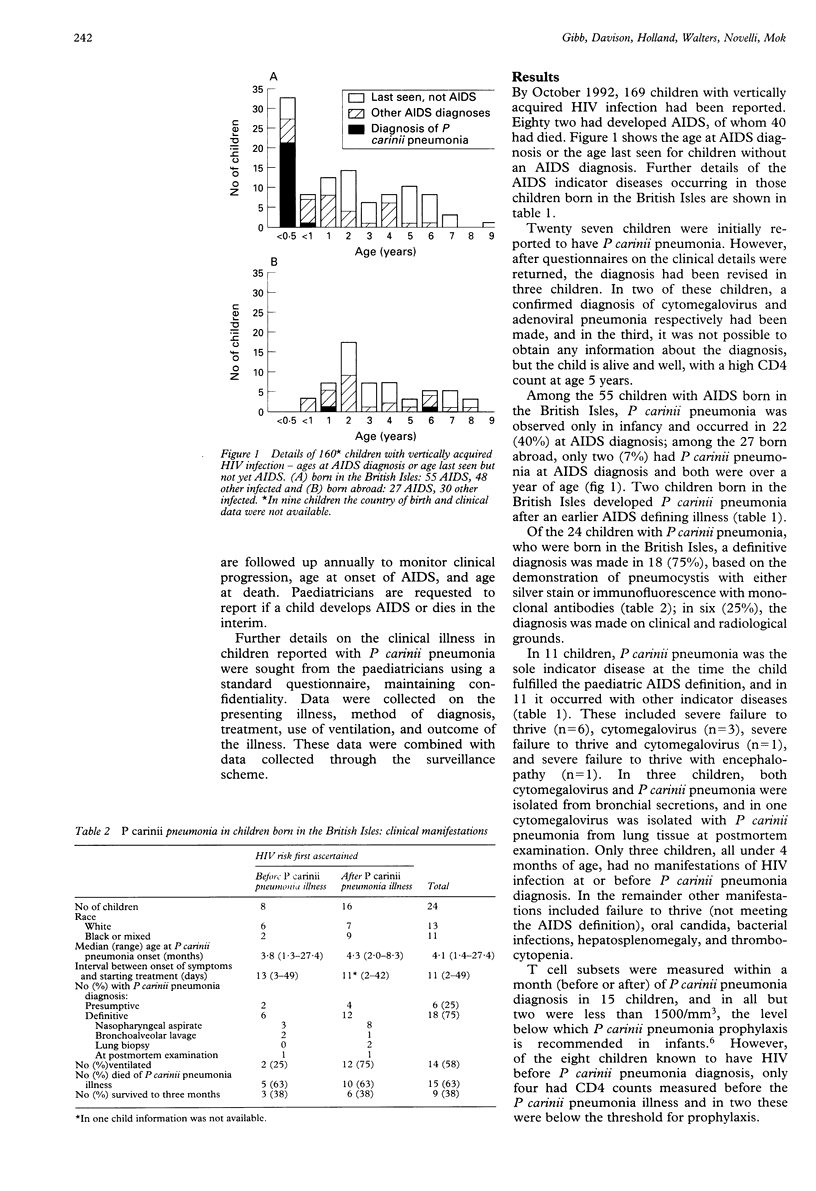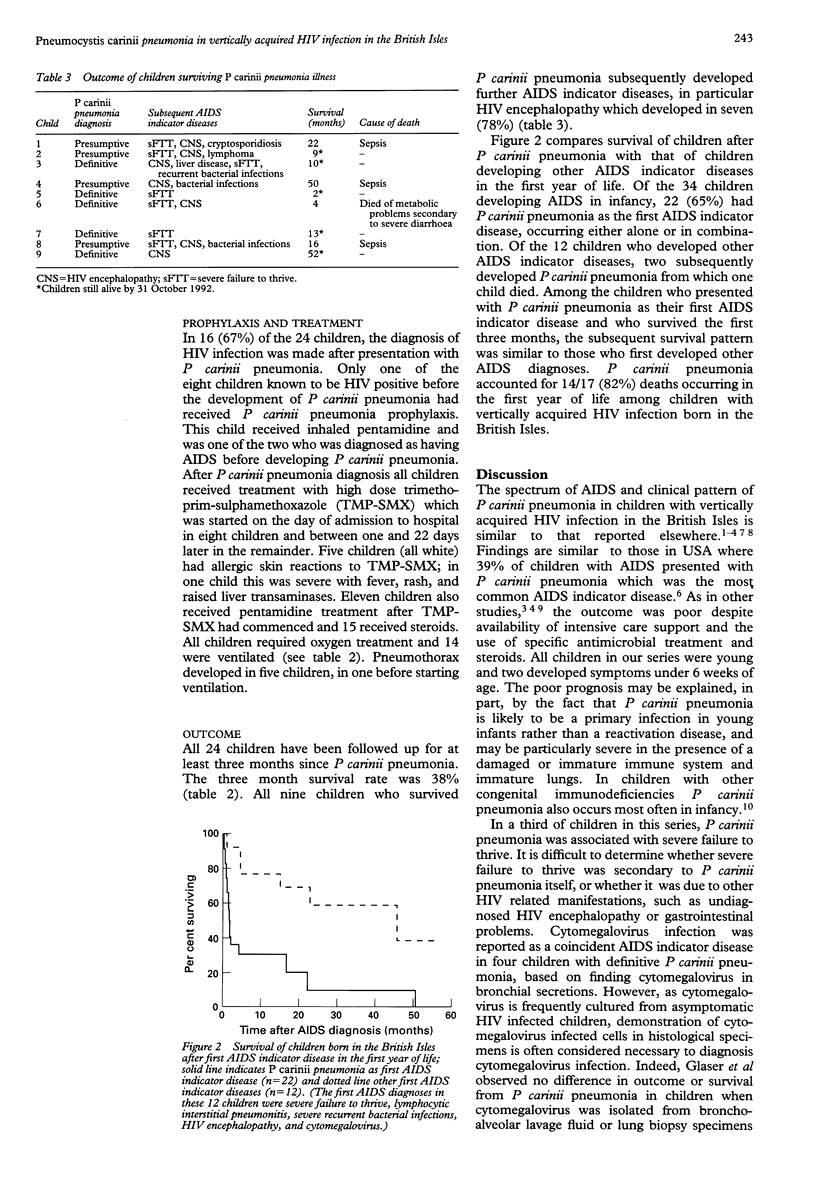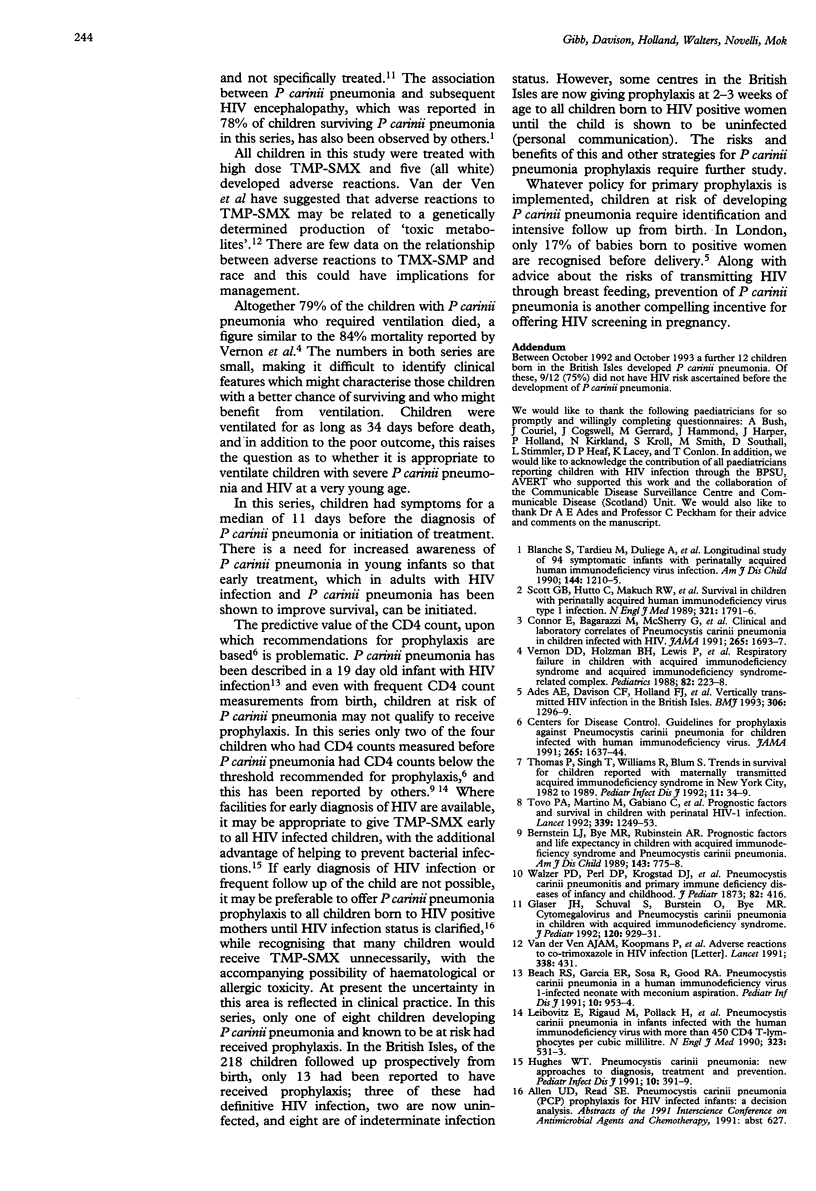Abstract
In order to review the clinical course, laboratory findings, and outcome of children with vertically acquired HIV infection and Pneumocystis carinii pneumonia, questionnaires were sent to paediatricians in the British Isles who had reported P carinii pneumonia and HIV infection through the British Paediatric Surveillance Unit (BPSU). Paediatric reports from the BPSU are linked to reports of pregnancies in HIV positive women and laboratory reports. P carinii pneumonia was the most frequently reported AIDS indicator disease at AIDS diagnosis, occurring in 22/56 (40%) children born in the British Isles; in a further two children P carinii pneumonia occurred after another AIDS indicator disease. The median age at P carinii pneumonia diagnosis was 4.1 (1.4-27.3) months and in 48% it occurred with other AIDS indicator diseases. Despite intensive treatment the three month survival was only 38%. The nine children surviving P carinii pneumonia subsequently developed further AIDS indicator diseases, in particular HIV encephalopathy and four have since died. P carinii pneumonia was present at AIDS diagnosis in 65% of children developing AIDS in the first year of life and caused 82% of infant deaths. Most children were not known to be at risk of HIV until they presented with P carinii pneumonia. Children with HIV infection develop P carinii pneumonia at an early age and have a poor outcome. Increased awareness of the condition is required to initiate early treatment. Prevention may be a compelling incentive for screening in pregnancy, but further study is required to quantify the risks and benefits of initiating early P carinii pneumonia prophylaxis as well as the impact this might have on life expectancy.
Full text
PDF



Selected References
These references are in PubMed. This may not be the complete list of references from this article.
- Ades A. E., Davison C. F., Holland F. J., Gibb D. M., Hudson C. N., Nicholl A., Goldberg D., Peckham C. S. Vertically transmitted HIV infection in the British Isles. BMJ. 1993 May 15;306(6888):1296–1299. doi: 10.1136/bmj.306.6888.1296. [DOI] [PMC free article] [PubMed] [Google Scholar]
- Beach R. S., Garcia E. R., Sosa R., Good R. A. Pneumocystis carinii pneumonia in a human immunodeficiency virus 1-infected neonate with meconium aspiration. Pediatr Infect Dis J. 1991 Dec;10(12):953–955. doi: 10.1097/00006454-199112000-00017. [DOI] [PubMed] [Google Scholar]
- Bernstein L. J., Bye M. R., Rubinstein A. Prognostic factors and life expectancy in children with acquired immunodeficiency syndrome and Pneumocystis carinii pneumonia. Am J Dis Child. 1989 Jul;143(7):775–778. doi: 10.1001/archpedi.1989.02150190025013. [DOI] [PubMed] [Google Scholar]
- Blanche S., Tardieu M., Duliege A., Rouzioux C., Le Deist F., Fukunaga K., Caniglia M., Jacomet C., Messiah A., Griscelli C. Longitudinal study of 94 symptomatic infants with perinatally acquired human immunodeficiency virus infection. Evidence for a bimodal expression of clinical and biological symptoms. Am J Dis Child. 1990 Nov;144(11):1210–1215. doi: 10.1001/archpedi.1990.02150350042021. [DOI] [PubMed] [Google Scholar]
- Connor E., Bagarazzi M., McSherry G., Holland B., Boland M., Denny T., Oleske J. Clinical and laboratory correlates of Pneumocystis carinii pneumonia in children infected with HIV. JAMA. 1991 Apr 3;265(13):1693–1697. [PubMed] [Google Scholar]
- Glaser J. H., Schuval S., Burstein O., Bye M. R. Cytomegalovirus and Pneumocystis carinii pneumonia in children with acquired immunodeficiency syndrome. J Pediatr. 1992 Jun;120(6):929–931. doi: 10.1016/s0022-3476(05)81965-1. [DOI] [PubMed] [Google Scholar]
- Hughes W. T. Pneumocystis carinii pneumonia: new approaches to diagnosis, treatment and prevention. Pediatr Infect Dis J. 1991 May;10(5):391–399. [PubMed] [Google Scholar]
- Leibovitz E., Rigaud M., Pollack H., Lawrence R., Chandwani S., Krasinski K., Borkowsky W. Pneumocystis carinii pneumonia in infants infected with the human immunodeficiency virus with more than 450 CD4 T lymphocytes per cubic millimeter. N Engl J Med. 1990 Aug 23;323(8):531–533. doi: 10.1056/NEJM199008233230807. [DOI] [PubMed] [Google Scholar]
- Scott G. B., Hutto C., Makuch R. W., Mastrucci M. T., O'Connor T., Mitchell C. D., Trapido E. J., Parks W. P. Survival in children with perinatally acquired human immunodeficiency virus type 1 infection. N Engl J Med. 1989 Dec 28;321(26):1791–1796. doi: 10.1056/NEJM198912283212604. [DOI] [PubMed] [Google Scholar]
- Tovo P. A., de Martino M., Gabiano C., Cappello N., D'Elia R., Loy A., Plebani A., Zuccotti G. V., Dallacasa P., Ferraris G. Prognostic factors and survival in children with perinatal HIV-1 infection. The Italian Register for HIV Infections in Children. Lancet. 1992 May 23;339(8804):1249–1253. doi: 10.1016/0140-6736(92)91592-v. [DOI] [PubMed] [Google Scholar]
- Vernon D. D., Holzman B. H., Lewis P., Scott G. B., Birriel J. A., Scott M. B. Respiratory failure in children with acquired immunodeficiency syndrome and acquired immunodeficiency syndrome-related complex. Pediatrics. 1988 Aug;82(2):223–228. [PubMed] [Google Scholar]
- van der Ven A. J., Koopmans P. P., Vree T. B., van der Meer J. W. Adverse reactions to co-trimoxazole in HIV infection. Lancet. 1991 Aug 17;338(8764):431–433. doi: 10.1016/0140-6736(91)91046-w. [DOI] [PubMed] [Google Scholar]


